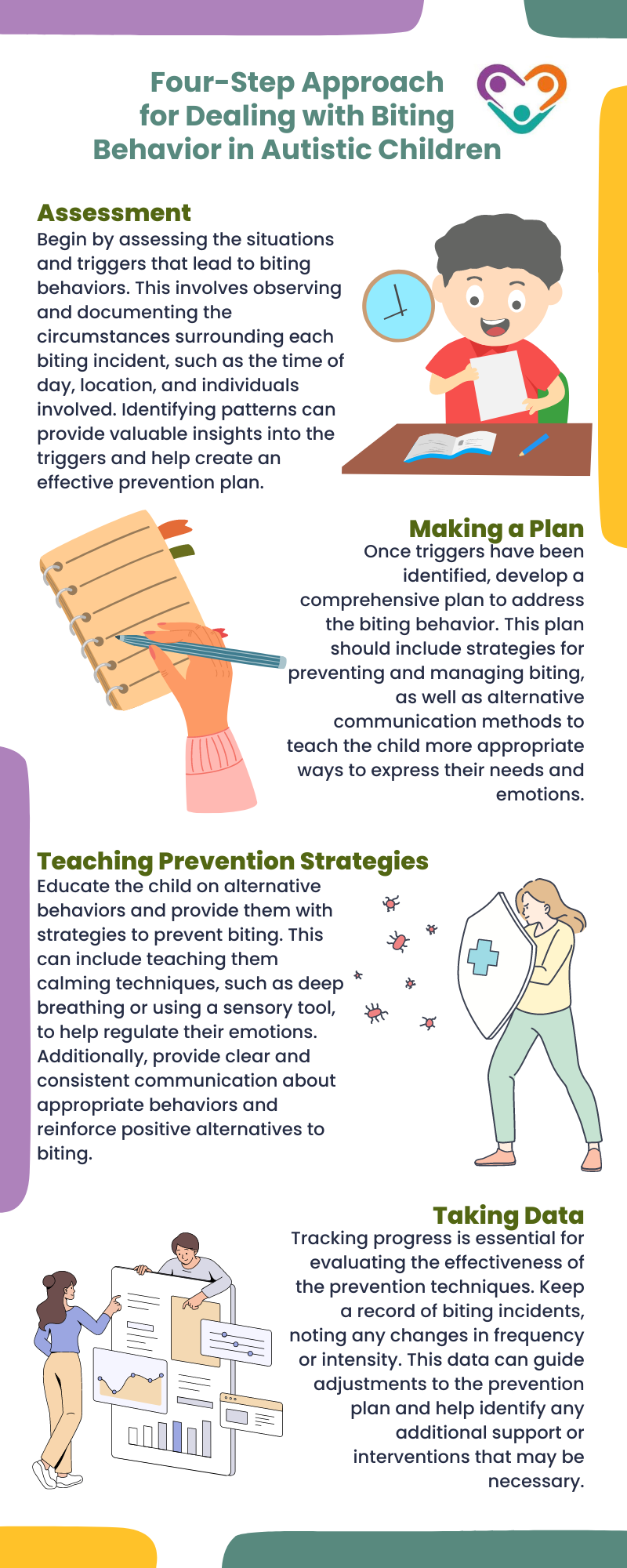
Table of Contents
Autistic children may resort to biting as a way to communicate their needs and feelings, even if they are capable of speaking. Due to communication deficits, they may struggle to express themselves verbally. This can ultimately lead to frustration, anxiety, or even unexplained rage attacks.
For them, biting can serve as a means of communication to signal distress or discomfort.
For parents and caregivers, they have to closely observe their child’s behavior and attempt to identify the triggers that lead to biting incidents. By understanding the specific situations or circumstances that prompt the biting behavior, they can work on implementing appropriate strategies to address the underlying communication challenges and reduce the likelihood of biting.
Identifying Triggers
To effectively address and stop the behavior of biting in autistic children, it is crucial to identify the triggers that may be contributing to this behavior. By understanding the underlying factors, parents and caregivers can implement appropriate strategies to prevent biting episodes.
There are two common triggers to consider in this situation which are the following:
Medical and Dental Factors
Biting in autistic children may be related to medical or dental causes. It is essential to rule out any underlying physical issues that may contribute to the behavior. Some children with autism may have hypersensitivity or oral health conditions that can lead to discomfort or pain, resulting in biting behavior as a way to alleviate their distress.
If you notice that the biting behavior is sudden or accompanied by signs of discomfort, it is advisable to consult a healthcare professional or dentist. They can assess the child’s oral health and identify any potential medical or dental factors that are potentially triggering the biting behavior.
Addressing these underlying issues can help alleviate the discomfort and reduce the likelihood of biting.
Sensory Sensitivities
Sensory sensitivities are common among individuals with autism. Biting behavior may serve as a sensory-seeking activity or a response to sensory overload. Autistic individuals may bite as a way to regulate their sensory input or to seek a specific sensory experience.
Introducing sensory tools can provide alternative ways for autistic children to meet their sensory needs, potentially reducing the tendency to bite. These tools can include items such as crunchy foods, chewy items, or sensory stim toys.
Offering appropriate sensory outlets can help fulfill the child’s sensory needs and redirect their biting behavior toward more acceptable forms of sensory stimulation.
Communication Strategies
Another way to address and stop biting behavior in autistic children is through the use of effective communication strategies. By providing alternative communication methods and utilizing sensory tools, parents and caregivers can help their children express their needs and reduce the likelihood of biting incidents.
For non-speaking autistic individuals or those with communication deficits, finding alternative ways to communicate is crucial.
Augmentative and alternative communication (AAC) devices, such as speech-generating devices or picture communication systems, can enhance their ability to express needs and struggles. These devices allow individuals to select symbols or words to convey their thoughts, feelings, and desires.
Sign language can also be an effective means of communication for some individuals.
Use of Sensory Tools
Sensory challenges can contribute to biting behavior in children with autism. Providing sensory tools and strategies can help individuals regulate their sensory experiences, reducing stress and frustration that may lead to biting.
Here are some sensory tools and techniques that can prove to be effective:
- Chewable items – Offering appropriate chewable items, such as chewy necklaces or bracelets, can redirect the child’s biting behavior toward a safer and more appropriate outlet. These items provide oral sensory stimulation and can help satisfy sensory needs.
- Weighted blankets or vests – These tools provide deep pressure input, which can have a calming effect on individuals with sensory sensitivities. The gentle pressure can help regulate their sensory system and reduce the likelihood of engaging in biting behaviors.
- Sensory breaks – Allowing scheduled breaks throughout the day to engage in sensory activities, such as swinging, jumping on a trampoline, or playing with sensory toys, can help individuals with autism regulate their sensory input. These breaks provide an opportunity to release excess energy and reduce the stress that may contribute to biting.
It’s important to note that sensory tools and strategies should be tailored to the individual’s specific sensory needs. Consulting with occupational therapists or sensory integration specialists can provide valuable guidance in selecting and implementing appropriate sensory tools.
Prevention Techniques
Prevention is key when it comes to addressing the issue of biting in autistic children. By implementing effective prevention techniques, parents and caregivers can help reduce the occurrence of biting behaviors.
There are two prevention techniques that parents and caregivers can use in this situation. These techniques are as follows:
Four-Step Approach
Tackling biting in autistic children requires a systematic approach that focuses on prevention. The four-step approach involves conducting an assessment, making a plan, teaching prevention strategies, and tracking progress through data collection.
This approach emphasizes the importance of understanding the underlying causes of the behavior and implementing proactive measures to prevent biting incidents. Let’s look at each step in further detail:
Providing Oral Sensory Outlets
For some autistic children, biting behavior may be a result of oral sensory needs. Providing appropriate outlets for these needs can help redirect biting behaviors to more acceptable forms of sensory stimulation.
One effective strategy is to offer sensory chews or similar oral tools. These tools are designed to provide a safe and appropriate outlet for oral sensory needs, helping to satisfy the child’s desire for oral stimulation. Sensory chews come in various shapes, sizes, and textures, allowing the child to choose the one that best meets their preferences.
By redirecting the child’s biting behavior to a sensory chew, they can engage in a more acceptable form of sensory stimulation. This can help reduce the urge to bite and provide a healthier outlet for their oral sensory needs.
It’s important to ensure that the sensory chew is safe, non-toxic, and appropriate for the child’s age and developmental stage.
Redirecting Behavior
Redirecting behavior is another important strategy for managing an autistic child who bites. It involves guiding the child towards more appropriate ways of expressing their needs and emotions. Redirecting can be particularly effective when the biting behavior is a result of stimming or self-stimulatory behaviors.
Stimming often occurs when a child with autism is overwhelmed, overstimulated, tired, uncomfortable, or bored. By identifying the triggers for stimming and providing alternative sensory outlets, such as sensory chews or fidget toys, the child can redirect their biting behavior to a more acceptable form of sensory stimulation
. This can help reduce the occurrence of biting and provide the child with a healthier outlet for self-expression.
When redirecting behavior, it is important to focus on positive reinforcement and praise. Acknowledge and reward the child when they engage in more appropriate behaviors or use alternative communication methods. This encourages the child to continue using these techniques and helps them understand that biting is not an acceptable way to express themselves.
By implementing the said strategies above, parents and caregivers can effectively manage the biting behavior in their autistic children. It is crucial to remember that each child is unique, and strategies may need to be tailored to their specific needs and preferences.
Consistency, patience, and understanding are key when working to address this challenging behavior.
Sources:
https://chubuddy.com/blogs/news/how-to-prevent-your-child-with-autism-from-biting
https://marybarbera.com/autism-and-biting
https://childresidentialtreatment.com/autistic-biting
- Autism Routine Disruption in Adults: Coping Tips - July 16, 2024
- Autism and Obsession: An Overview - July 16, 2024
- Autism and Taking Clothes Off: Management Tips - July 16, 2024





